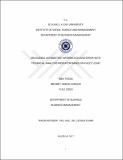Please use this identifier to cite or link to this item:
http://hdl.handle.net/11547/1411Full metadata record
| DC Field | Value | Language |
|---|---|---|
| dc.contributor.author | Songün, Mehmet Harun | - |
| dc.date.accessioned | 2019-04-18T06:15:52Z | - |
| dc.date.available | 2019-04-18T06:15:52Z | - |
| dc.date.issued | 2017-06 | - |
| dc.identifier.uri | http://hdl.handle.net/11547/1411 | - |
| dc.description.abstract | Bu tez yaygın olarak kullanılan üç osilatörü denetledi, Üssel Hareketli Ortalama son donem fiyat verilerine ağırlık verir, Hareketli Ortalama Uyumu/Uyumsuzluğu iki farklı hareketli ortalama arasındaki farkı gösterir, Göreceli Güç Endeksi son fiyat verilerine göre aşırı alimi ve aşırı satışı işaret eder. Bu osilatörüden gelen verileri dengeli bir bicimde karsılaştırmak için, biz bu üç osilatörün çıktı sonuçlarına bazı terimler vererek tanımladık, bunlar Buy-Buy (Al-Al), Buy-Sell (Al-Sat), Sell-Buy (Sat-Al) ve Sell-Sell (Sat-Sat). Ancak ayni zaman dilimine ait bu üç osilatörüden gelen çıktı verileri genellikle birbirinden farklılık gösterdi. Ortaya çıkan belirsizliği, belirsizlikle bütünleşerek bu sorunların üstesinden gelmeye çalıştık. Bu durumda bulanık mantık yaklaşımı ve bulanık kümeler kuramını kullanarak üç karar yerine bir karar almak problem çözdü. Ve ayni zamanda, bulanıklaştırma borsa giriş ve çıkış zamanlamalarını sinyalizasyonunda daha iyi tahmin ve karar verme yeteneği sağladı. Bulanıklaştırmadan oluşturulan sinyaller ve teknik göstergelerin oluşturduğu sinyaller indeks ve osilatör bazında korelâsyonu incelendi. Ayrıca, endekslerin günlük kapanış verileri asimetrik eşbütünleştirme ve hata durumu kontrol edildi. Farklı yatırım stratejilerinden oluşan aynı teknik analiz sinyalinin doğru karar yüzdesi finansal piyasaların para hareketlerini daha iyi anlaşılabilmesi için karşılaştırıldı. | tr_TR |
| dc.language.iso | en | tr_TR |
| dc.publisher | İSTANBUL AYDIN UNIVERSITY INSTITUTE OF SOCIAL SCIENCE | tr_TR |
| dc.subject | EMA | tr_TR |
| dc.subject | MACD | tr_TR |
| dc.subject | RSI | tr_TR |
| dc.subject | Bulanık Mantık | tr_TR |
| dc.subject | Finansal Piyasalar | tr_TR |
| dc.subject | EMA | tr_TR |
| dc.subject | MACD | tr_TR |
| dc.subject | RSI | tr_TR |
| dc.subject | Fuzzy Logic | tr_TR |
| dc.subject | Financial Markets | tr_TR |
| dc.title | MEASURING ASYMMETRIC INFORMATION AND ERROR WITH TECHNICAL ANALYSIS INDICATOR BASED ON FUZZY LOGIC | tr_TR |
| dc.type | Thesis | tr_TR |
| dc.description.abstractol | This thesis examines three widely used oscillators, the Exponential Moving Average which provides an average price, the Moving Average Convergence Divergence which is a momentum indicator that shows the strength of price movement in a market, and the Relative Strength Index which aims to indicate overbought or oversold market condition in relation to recent price levels. We must also understand indices, which include daily closing values which are compared for their asymmetric information and error, and help for better understanding on price movements of financial markets by the right decision percentage of the same indicator signal, which comes from different trading strategies. To compare the values of oscillators equally, we define output values of these three oscillators by giving terms such as Buy-Buy, Buy-Sell, Sell-Buy and Sell-Sell. However, outputs of these three oscillators were different from each other most of the time, for a given period. The uncertainty which emerges in this case can therefore be concluded by using the Fuzzy Logic approach, which sets for one resolution instead of three to solve the problem. In addition, Fuzzification also results in a better ability to forecast and decide the timing of stock market entry and exit. In order to test this approach’s validation and examine the correlation between oscillators and indices, one could compare the signals that have been generated by Fuzzification and the signals that have been generated individually from technical indicators. | tr_TR |
| Appears in Collections: | Tezler -- Thesis | |
Files in This Item:
| File | Description | Size | Format | |
|---|---|---|---|---|
| MEASURING ASYMMETRIC INFORMATION AND ERROR WITH.pdf | Yüksek Lisans Tez Dosyası | 1.97 MB | Adobe PDF |  View/Open |
Items in DSpace are protected by copyright, with all rights reserved, unless otherwise indicated.
